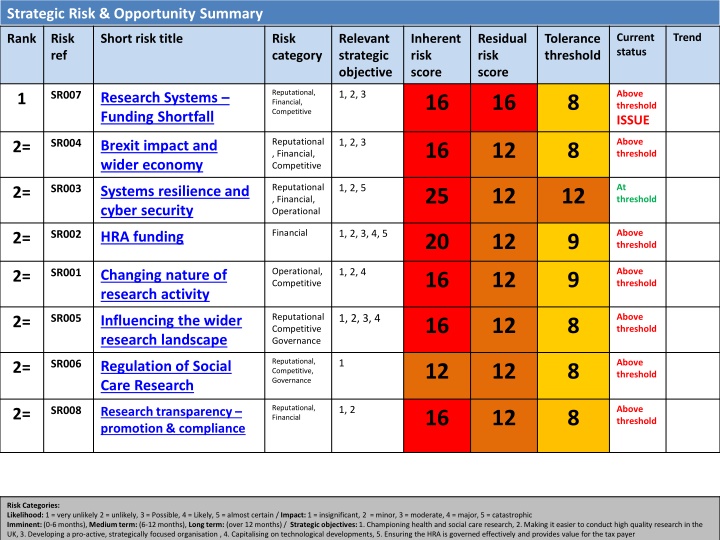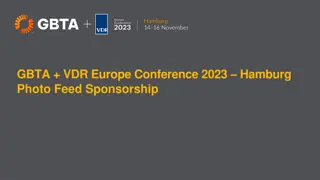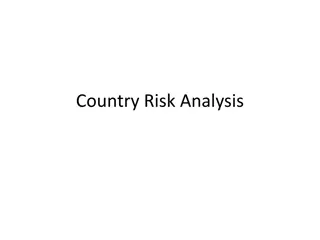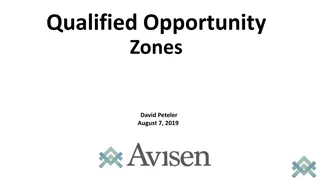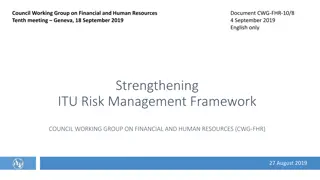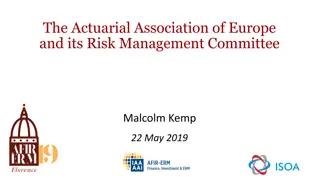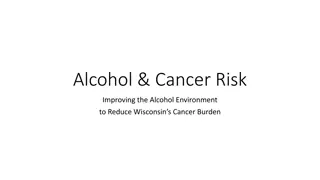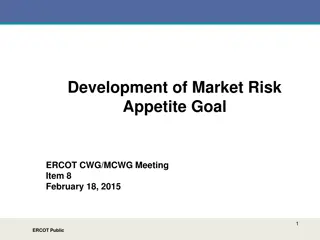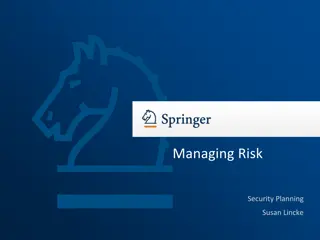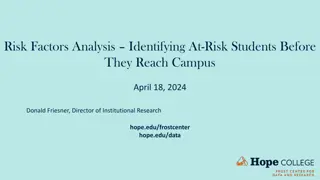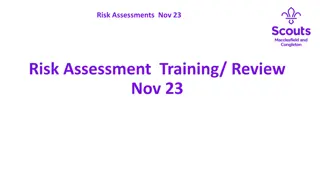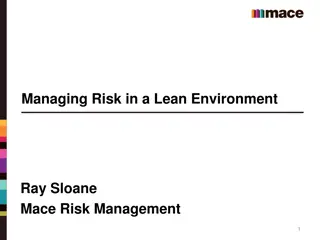Strategic Risk & Opportunity Summary
The report provides an overview of current strategic risks and opportunities, including issues such as research funding shortfalls, the impact of Brexit on the economy, and challenges related to systems resilience and cyber security. It highlights the importance of addressing changing research activity requirements to maintain competitiveness and reputation in the global research landscape.
Download Presentation

Please find below an Image/Link to download the presentation.
The content on the website is provided AS IS for your information and personal use only. It may not be sold, licensed, or shared on other websites without obtaining consent from the author.If you encounter any issues during the download, it is possible that the publisher has removed the file from their server.
You are allowed to download the files provided on this website for personal or commercial use, subject to the condition that they are used lawfully. All files are the property of their respective owners.
The content on the website is provided AS IS for your information and personal use only. It may not be sold, licensed, or shared on other websites without obtaining consent from the author.
E N D
Presentation Transcript
Strategic Risk & Opportunity Summary Current status Trend Rank Risk ref Short risk title Risk category Relevant strategic objective Inherent risk score 16 Residual risk score 16 Tolerance threshold Reputational, Financial, Competitive Above threshold ISSUE 1, 2, 3 SR007 Research Systems Funding Shortfall 1 8 Reputational , Financial, Competitive Above threshold 1, 2, 3 SR004 Brexit impact and wider economy 2= 16 12 8 Reputational , Financial, Operational At threshold 1, 2, 5 SR003 Systems resilience and cyber security 2= 25 12 12 Financial Above threshold 1, 2, 3, 4, 5 SR002 HRA funding 2= 20 12 9 Operational, Competitive Above threshold 1, 2, 4 SR001 Changing nature of research activity 2= 16 12 9 Reputational Competitive Governance Above threshold SR005 1, 2, 3, 4 Influencing the wider research landscape 2= 16 12 8 Reputational, Competitive, Governance Above threshold 1 SR006 Regulation of Social Care Research 2= 12 12 8 Reputational, Financial Above threshold 1, 2 SR008 Research transparency promotion & compliance 2= 16 12 8 Risk Categories: Likelihood: 1 = very unlikely 2 = unlikely, 3 = Possible, 4 = Likely, 5 = almost certain / Impact: 1 = insignificant, 2 = minor, 3 = moderate, 4 = major, 5 = catastrophic Imminent: (0-6 months), Medium term: (6-12 months), Long term: (over 12 months) / Strategic objectives: 1. Championing health and social care research, 2. Making it easier to conduct high quality research in the UK, 3. Developing a pro-active, strategically focused organisation , 4. Capitalising on technological developments, 5. Ensuring the HRA is governed effectively and provides value for the tax payer
Risk Details Risk Ref: Short title: Risk category: Date identified: Status: Date updated: Operational, Competitive Nov 2017 Open 15/01/2019 Changing nature of research activity SR001 Scope of Risk Risk Description Cause Effect Strategic Obj. There is a risk that the HRA is unable to meet the changing requirements of research activity in the future and is therefore unable to make the UK competitive on a global scale. There is uncertainty regarding what the changing requirements may be, what role amongst other stakeholders the HRA may have and the HRA has limited resources and may lack capacity and capability to implement changes to systems, process and ways of working at the required speed of change The HRA is not set up in the best way to manage future research requirements with damage to the HRA s reputation, frustration amongst the research community, delays in research approval and research taking place elsewhere. 1, 2, 4 Nature of Risk Inherent Risk Residual Risk Tolerance Timing Trend Likelihood Impact Total Likelihood Impact Total Threshold Imminent /Medium-term / Long-term Q1 Q2 Q3 Q4 Long-term 4 4 16 3 4 12 9 Mitigations and response plan Current mitigations Owner Date Future actions Owner Due date Investing in workforce and systems now to meet future demands, work of Transformation Board, including new IRAS and T.O.M. IC Ongoing Horizon scanning workshop required - Identification and impact of future research activity such as big data, apps, ageing population to be explored TBC Flexible & adaptable workforce N/A Ongoing Identify possible opportunities e.g. Office for Life Sciences TBC AI workshop held and existing frameworks appear to be relatively appropriate to manage the potential workload JT 07.18 Policy engagement strategy discussion at Board JT 01.19 HRA Approvals processes flexible enough to handle innovation JM Ongoing Risk Categories: Reputational, Financial, Competitive, Operational, Governance Likelihood: 1 = very unlikely 2 = unlikely, 3 = Possible, 4 = Likely, 5 = almost certain / Impact: 1 = insignificant, 2 = minor, 3 = moderate, 4 = major, 5 = catastrophic Imminent: (0-3 months), Medium term: (3-6 months), Long term: (over 6months) / Strategic objectives: 1. Championing health and social care research, 2. Making it easier to conduct high quality research in the UK, 3. Developing a pro-active, strategically focused organisation , 4. Capitalising on technological developments, 5. Ensuring the HRA is governed effectively and provides value for the tax payer
Risk Details Risk Ref: Short title: Risk category: Date identified: Status: Date updated: Operational, Competitive Nov 2017 Open 15/01/2019 Changing nature of research activity SR001 Commentary Above tolerance threshold Uncertainty regarding what the changing nature of research activity may be and the impact this will have. Horizon scanning workshop & intelligence gathering required to understand issues further. Workshop held on AI indicated our existing frameworks would largely be applicable to managing AI research whether this would apply to other forms of research requires further exploration. The speed at which change takes place will be significant and important for the HRA to be ahead of the game and ensure policy position as well as operational readiness is considered. Board seminar discussion around breadth and depth of strategy and ambition with further proposals to come for future Board discussion New and innovative technological platforms for collaboration and research are developing, but need to be balanced with security, control and public safety. The ethical implications of technological developments are an area that the HRA is focused on to ensure that the public are safeguarded and risks are mitigated. The HRA will adopt an innovative approach to regulation relating to new technology to continue to enable high quality research in this area.
Risk Details Risk Ref: Short title: Risk category: Date identified: Status: Date updated: Financial Nov 2017 Open 15/01/2019 HRA funding SR002 Scope of Risk Risk Description Cause Effect Strategic Obj. The HRA is unable to deliver its strategic aims and objectives alongside its core operational remit. HRA s funding is further reduced due to the economic climate in the UK and GIA adjustments to move funds to frontline services and / or our remit grows to include wider responsibilities without additional funding being provided. The HRA is forced to focus on its core operational remit and it is unable to deliver its strategic objectives. 1, 2, 3, 4 Nature of Risk Inherent Risk Residual Risk Tolerance Timing Trend Likelihood Impact Total Likelihood Impact Total Threshold Imminent /Medium-term / Long-term Q1 Q2 Q3 Q4 Imminent 5 4 20 4 3 12 9 Mitigations and response plan Current mitigations Owner Date Future actions Owner Due date Target Operating Model developed to free up resource to support strategic objective delivery. IC Ongoing Identify possible opportunities for support e.g. Office for Life Sciences TBC KW Ongoing Prioritisation of corporate workload via the SLT TA Ongoing Secure new funding for innovation and areas which have the potential to impact on routine service e.g. Brexit Explore partnerships/ alliances with other organisations to spread the load (SLT) TA Ongoing Actively seek funding where it may arise to fund particular strategic projects KW Ongoing RS business case in tech automation to support TOM KW Sept 2020 Risk Categories: Reputational, Financial, Competitive, Operational, Governance Likelihood: 1 = very unlikely 2 = unlikely, 3 = Possible, 4 = Likely, 5 = almost certain / Impact: 1 = insignificant, 2 = minor, 3 = moderate, 4 = major, 5 = catastrophic Imminent: (0-3 months), Medium term: (3-6 months), Long term: (over 6months) / Strategic objectives: 1. Championing health and social care research, 2. Making it easier to conduct high quality research in the UK, 3. Developing a pro-active, strategically focused organisation , 4. Capitalising on technological developments, 5. Ensuring the HRA is governed effectively and provides value for the tax payer
Risk Details Risk Ref: Short title: Risk category: Date identified: Status: Date updated: Financial Nov 2017 Open 15/01/2019 HRA funding SR002 Commentary Above threshold Work associated with Brexit and Replacement of IRAS have only been partially funded. Future mitigation intention is to secure additional funding to help spread the cost during 2019/2020 via follow-up business case to DHSC Explore AI potential as a Phase 2 development to automate more activity & apply for funds via innovation application Establish whether there is an opportunity to access some additional funding via partnerships with other organisations Consider whether MHRA might become the CTR system owner for interface platforms linked to EUCTR e.g. mulesoft Savings targets set across HRA for 2019/20 Minimal reserves, impact of Select Committee report to consider further.
Risk Details Risk Ref: Short title: Risk category: Date identified: Status: Date updated: Reputational, Financial, Operational Nov 2017 Open 15/01/2019 Systems resilience and cyber security SR003 Scope of Risk Risk Description Cause Effect Strategic Obj. Personal or commercially sensitive data is lost causing reputational damage to the HRA, a loss of public confidence and requires significant costs to retrieve / resolve . Systems are significantly affected resulting in an loss of service to the research community and subsequent reputational damage. There is a risk that the HRA s operational delivery or strategic influence is seriously affected by a successful and destructive cyber attack The HRA s key systems suffer a successful cyber attack or incident 1, 2, 5 Nature of Risk Inherent Risk Residual Risk Tolerance Timing Trend Likelihood Impact Total Likelihood Impact Total Threshold Imminent /Medium-term / Long-term Q1 Q2 Q3 Q4 Imminent 5 5 25 4 3 12 12 Mitigations and response plan Current mitigations Owner Date Future actions Owner Due date HGIAS cyber security audit held and actions implemented KW 11/2016 Further incident scenarios planned ST 03/2019 ATOS managed service environment in place KW Ongoing Observation of NHS BT incident scenario ST 03/2019 KW Regular communications to staff and supporting guidance helps maintain a good level of awareness of the risks Ongoing Future Service Programme to replace Atos contract includes high spec for cyber resilience KW 05/2020 KW Mandatory Training provided to staff includes specific training relating to phishing emails Ongoing Further development of business continuity plans ST 12/2018 Wannacry incident scenario exercise held ST 03/18 Sign up to complete the Data Security and Protection Toolkit KW 11/2018 IT Security Plan in place (see commentary overleaf) KW Ongoing Risk Categories: Reputational, Financial, Competitive, Operational, Governance Likelihood: 1 = very unlikely 2 = unlikely, 3 = Possible, 4 = Likely, 5 = almost certain / Impact: 1 = insignificant, 2 = minor, 3 = moderate, 4 = major, 5 = catastrophic Imminent: (0-3 months), Medium term: (3-6 months), Long term: (over 6months) / Strategic objectives: 1. Championing health and social care research, 2. Making it easier to conduct high quality research in the UK, 3. Developing a pro-active, strategically focused organisation , 4. Capitalising on technological developments, 5. Ensuring the HRA is governed effectively and provides value for the tax payer
Risk Details Risk Ref: Short title: Risk category: Date identified: Status: Date updated: Reputational, Financial, Operational Nov 2017 Open 15/01/2019 Systems resilience and cyber security SR003 Commentary At tolerance threshold The key business critical systems are the Integrated Research Applications System (IRAS), the HRA Assessment Review Portal (HARP), the ATOS systems (a managed service environment providing controlled access to email (NHS Mail via Outlook), internet, intranet, shared drives and other bespoke / dedicated software), and the Finance and HR systems. HRA Security Management documentation available which details how the confidentiality, integrity, and availability of information will be ensured through the implementation of IT security measures via Vysiion. HRA IT Security Plan available which governs the integrity, and security of the HRA s information stored in the databases linked to the systems HARP, IRAS, GFI and TOPS. As such it conforms to the HMG Security Policy Framework. The document details the governance arrangements, roles and responsibilities, training and policies and procedures and processes; which include access control, hardening of servers, penetration and ethical hacking testing, anti-virus testing, back-up and restore, and disaster recovery to name but a few. Recent work includes increasing the patching of the Window server software to twice a month to ensure the software is up to date and also enhancing the software to mitigate vulnerabilities recommended by the penetration testing HGIAS audit conducted 11/2016 with a limited rating issued. Subsequent work to rectify issues undertaken and all actions now completed. Wannacryincident scenario undertaken with action and learning plan agreed including observation of NHS BT scenario. Further review and development of business continuity plans
Risk Details Risk Ref: Short title: Risk category: Date identified: Status: Date updated: Reputational, Financial, Competitive Nov 2017 Open 15/01/2019 Brexit impact and wider economy SR004 Scope of Risk Risk Description Cause Effect Strategic Obj. There is a risk there is a mismatch between the capacity of the HRA and the level of research activity taking place There is considerable uncertainty regarding the impact of Brexit on the UK research environment. The scale of research taking place may rise or fall as a result of the impact of Brexit and the HRA may not be able to cope with the increased / reduced demand. 1, 2, 3 Nature of Risk Inherent Risk Residual Risk Tolerance Timing Trend Likelihood Impact Total Likelihood Impact Total Threshold Imminent /Medium-term / Long-term Q1 Q2 Q3 Q4 Long-term 4 4 16 4 3 12 8 Mitigations and response plan Current mitigations Owner Date Future actions Owner Due date Active monitoring of applications activity JM Ongoing Horizon scanning workshop required TBC Use intelligence supplied at Steering Board meetings with DeXEU, OLS and DHSC to inform planning TA Ongoing Activity forecasts to identify future trends with alerts KW End of 2018 Link to Informatics centre at University of Newcastle so tap into intelligence monitoring TA End Q3 2018 Link activity forecasts to business planning processes KW End of Q4 2018 Risk Categories: Reputational, Financial, Competitive, Operational, Governance Likelihood: 1 = very unlikely 2 = unlikely, 3 = Possible, 4 = Likely, 5 = almost certain / Impact: 1 = insignificant, 2 = minor, 3 = moderate, 4 = major, 5 = catastrophic Imminent: (0-3 months), Medium term: (3-6 months), Long term: (over 6months) / Strategic objectives: 1. Championing health and social care research, 2. Making it easier to conduct high quality research in the UK, 3. Developing a pro-active, strategically focused organisation , 4. Capitalising on technological developments, 5. Ensuring the HRA is governed effectively and provides value for the tax payer
Risk Details Risk Ref: Short title: Risk category: Date identified: Status: Date updated: Reputational, Financial, Competitive Nov 2017 Open 15/01/2019 Brexit impact and wider economy SR004 Commentary Above tolerance threshold Extend current application activity monitoring into a forecasting tool with trigger/alerts set for action TA has contacted the University of Newcastle who have already developed tools for research forecasting to establish whether they can mine our RS and whether we can access intelligence that they are producing for Life Sciences Sector. This would allow us to have an early advance warning system of changes that are likely to impact on the whole UK research economy Maintain key links to major funders & NHSE commissioners to ensure that we are collecting intelligence from them about on the ground changes across the NHS which are less visible at a strategic level
Risk Details Risk Ref: Short title: Risk category: Date identified: Status: Date updated: Reputational, Competitive, Governance Nov 2017 Open 15/01/2019 Influencing the wider research landscape SR005 Scope of Risk Risk Description Cause Effect Strategic Obj. There is a risk the HRA is unable to deliver its strategic aim and make the UK a great place to conduct research The HRA does not have the resource or remit to influence the wider research community to support the delivery of its strategic objectives. Improvements to the research landscape are not delivered or delivered slower than researchers require. There is damage reputational to the way the HRA is perceived and the UK is not seen as an attractive place to do research. 1, 2, 3, 4, Nature of Risk Inherent Risk Residual Risk Tolerance Timing Trend Likelihood Impact Total Likelihood Impact Total Threshold Imminent /Medium-term / Long-term Q1 Q2 Q3 Q4 4 4 16 3 4 12 8 Medium-term Mitigations and response plan Current mitigations Owner Date Future actions Owner Due date Transformation work including Service Improvement Programme and Target Operating Model to ensure the organisation is set up appropriately to allow focus on delivery of strategic objectives IC Ongoing Engagement strategy published JT 02/2019 Engagement strategy project begun JT 07/2018 Define priority areas for influence and build into the planning processes (SLT) TA Good working relationships with 4 Nations policy leads TA Ongoing Board seminar considering ambition linked to horizon scanning and future landscape JT 07/2018 Risk Categories: Reputational, Financial, Competitive, Operational, Governance Likelihood: 1 = very unlikely 2 = unlikely, 3 = Possible, 4 = Likely, 5 = almost certain / Impact: 1 = insignificant, 2 = minor, 3 = moderate, 4 = major, 5 = catastrophic Imminent: (0-3 months), Medium term: (3-6 months), Long term: (over 6months) / Strategic objectives: 1. Championing health and social care research, 2. Making it easier to conduct high quality research in the UK, 3. Developing a pro-active, strategically focused organisation , 4. Capitalising on technological developments, 5. Ensuring the HRA is governed effectively and provides value for the tax payer
Risk Details Risk Ref: Short title: Risk category: Date identified: Status: Date updated: Reputational, Competitive, Governance Nov 2017 Open 15/01/2019 Influencing the wider research landscape SR005 Commentary Above tolerance threshold Service Improvement Programme and Target Operating Model intention ongoing to ensure the organisation is fit for purpose, continues to deliver core function but is able to focus on delivery of strategic objectives and support wider research environment improvements. We want to make the HRA a proactive, strategically-focussed organisation; we want to champion health and social care research for the benefit of patients and the public and we want to make it easy to carry out high quality research. We have been clear since our establishment that we achieve these aims by influencing others to do what they are best placed to do, by working with partners to do what is best achieved in collaboration, and by ensuring we make a success of what the Health Research Authority alone is empowered to do. The evolving work on our strategic ambition, linked to a new stakeholder engagement strategy will define the nature of priority relationships and partnerships over the next 9 months
Risk Details Risk Ref: Short title: Risk category: Date identified: Status: Date updated: Reputational, Competitive, Governance Nov 2017 Open 15/01/2019 Regulation of Social Care Research SR006 Scope of Risk Scope of Risk Risk Description Cause Effect Strategic Obj. There is a risk the HRA is not adequately fulfilling its remit to protect participants and potential participants in social care research The scale and nature of social care research is not fully understood with applications not being submitted for the appropriate review and approval. Research participants may be harmed or adversely affected from participation in social care research 1 Nature of Risk Inherent Risk Residual Risk Tolerance Timing Trend Likelihood Impact Total Likelihood Impact Total Threshold Imminent /Medium-term / Long-term Q1 Q2 Q3 Q4 3 4 12 3 4 12 8 Medium-term Mitigations and response plan Current mitigations Owner Date Future actions Owner Due date Identification and understanding of problems following round table discussion and HRA Board review JT July 18 / Sept 18 Development of a five year strategy and plan with experts JT End of Q1 2019 High level expectations in place as part of UK Policy Framework JT 2017 Supporting development of social care friendly advice - Development of good practice guidance/training/website and supporting the development of research culture JT End of Q3 2019 Ongoing engagement with Social Care Research Community and the establishment of the collaboration forum JT Ongoing Identify optimal processes for handling social care research and build into new IRAS/approvals process JM End Q4 2019 Risk Categories: Reputational, Financial, Competitive, Operational, Governance Likelihood: 1 = very unlikely 2 = unlikely, 3 = Possible, 4 = Likely, 5 = almost certain / Impact: 1 = insignificant, 2 = minor, 3 = moderate, 4 = major, 5 = catastrophic Imminent: (0-3 months), Medium term: (3-6 months), Long term: (over 6months) / Strategic objectives: 1. Championing health and social care research, 2. Making it easier to conduct high quality research in the UK, 3. Developing a pro-active, strategically focused organisation , 4. Capitalising on technological developments, 5. Ensuring the HRA is governed effectively and provides value for the tax payer
Risk Details Risk Ref: Short title: Risk category: Date identified: Status: Date updated: Reputational, Competitive, Governance Nov 2017 Open 15/01/2019 Regulation of Social Care Research SR006 Commentary Above tolerance threshold Whilst the inherent risk scores and residual risk scores are both showing as 12 there has been considerable progress in scoping and understanding the risk with clear steps identified in the future, in particular with the development of the Collaboration Forum, to mitigate this risk. Working with experts in the social care sector to develop a five year plan for social care research, which is proportionate to the risks and aligned to the anticipated increase in the number of studies arising from this critical part of the health and care sector.
Risk Details Risk Ref: Short title: Risk category: Date identified: Status: Date updated: Reputational, Financial, Competitive Nov 2018 Open 15/01/2019 Research Systems funding shortfall SR007 Scope of Risk Risk Description Cause ISSUE Effect Strategic Obj. The development of a highly effective, customer centric, streamlined, quality research regulatory system is a key factor in making the UK an attractive place to carry out research. Our inability to do so would have a significant impact on customer experience, service delivery, sector intelligence and ultimately the HRA s and UK s reputation The inability to capitalise on technological developments to ensure our research systems meet the requirements of the health research community in the immediate term. Unable to secure additional investment to support the full transformation of HRA research systems to a single platform. 1, 2, 3 Nature of Risk Inherent Risk Residual Risk Tolerance Timing Trend Likelihood Impact Total Likelihood Impact Total Threshold Imminent /Medium-term / Long-term Q1 Q2 Q3 Q4 Imminent 4 4 16 4 4 16 8 Mitigations and response plan Current mitigations Owner Date Future actions Owner Due date Business Case developed and presented to DHSC KW 7/11 Developing no funding scenarios SLT 30/11 Meeting with sponsor to discuss case TA/JM/ KW/IC 22/11 Engaged PA Consulting to carry out an assurance exercise on RS Strategy IC 30/11 HRA to establish a contingency option involving a small team of developers IC/GCP 29/11 Procure or recruit to posts in plan Restructure of existing team to achieve skills mix & expertise required for new and existing systems IC/GCP 19/12/18 EU Exit funding proposals submitted KW 19/10 Risk Categories: Reputational, Financial, Competitive, Operational, Governance Likelihood: 1 = very unlikely 2 = unlikely, 3 = Possible, 4 = Likely, 5 = almost certain / Impact: 1 = insignificant, 2 = minor, 3 = moderate, 4 = major, 5 = catastrophic Imminent: (0-3 months), Medium term: (3-6 months), Long term: (over 6months) / Strategic objectives: 1. Championing health and social care research, 2. Making it easier to conduct high quality research in the UK, 3. Developing a pro-active, strategically focused organisation , 4. Capitalising on technological developments, 5. Ensuring the HRA is governed effectively and provides value for the tax payer
Risk Details Risk Ref: Short title: Risk category: Date identified: Status: Date updated: Reputational, Financial, Competitive Nov 2018 Open 21/11/2018 Research Systems funding shortfall SR007 Commentary Above tolerance threshold New IRAS in development however will only deliver part of required solution, resulting in a fragmented and complicated partial solution Risk to business as usual delivery and KPIs given resourcing requirements to manage complicated partial solution Business case considered 3 options the preferred option being to move quickly to a total replacement of IRAS and HARP by Sep 2020 DHSC initial response raised a number of questions related to additional funding EU Exit funding bit submitted to HM Treasury in October 500k committed to support phase 1 programme in 2018/19 Detailed work being carried out by Implementation Partner and DD Research System in determining resourcing model from February 2019 (based on funded and not funded scenarios) May require further conversations with DHSC Senior Leaders to make the case possibly link into the new health technology expert group Opportunity to link technology improvements with political focus on transparency and our ability to operate as a modern regulator capitalising on technological developments to improve awareness, remove barriers and improve transparency ISSUE
Risk Details Risk Ref: Short title: Risk category: Date identified: Status: Date updated: Reputational, Financial Nov 2018 Open 15/01/2019 Research transparency - promotion & compliance SR008 Scope of Risk Scope of Risk Risk Description Cause Effect Strategic Obj. The HRA is unable to sufficiently influence the transparency landscape to ensure all research taking place in the UK fulfils transparency requirements and also fails to adequately promote transparency through its work with other stakeholders. An opportunity is missed to increase compliance by researchers with research transparency requirements and to make the dissemination of research findings the norm. There is poor public and patient confidence in research and limited trust in research findings with the HRA s reputation adversely affected and its strategic objectives not achieved. The HRA has limited resources and may lack capacity to deliver the recommendations from the House of Commons Science & Technology Committee for Research integrity: clinical trials transparency and its duty to promote transparency. 1, 2, Nature of Risk Inherent Risk ResidualRisk Tolerance Timing Trend Likelihood Impact Total Likelihood Impact Total Threshold Imminent /Medium-term / Long-term Q1 Q2 Q3 Q4 4 4 16 3 4 12 8 Long-term Mitigations and response plan Current mitigations Owner Date Future actions Owner Due date HRA publication of research summary records & Clinical trial registration a condition of REC approval JM 2013 Research transparency strategy to be developed setting out how Select Committee recommendations can be achieved JT 2019 HRA signed up to Alltrials, & Lancet REWARD Campaign Development of new IRAS to support best practice around publication and dissemination Transparency forum established with remit to promote transparency and understand opportunities , obstacles and levers Survey to create a baseline of transparency understanding completed JT 2018 Risk Categories: Reputational, Financial, Competitive, Operational, Governance Likelihood: 1 = very unlikely 2 = unlikely, 3 = Possible, 4 = Likely, 5 = almost certain / Impact: 1 = insignificant, 2 = minor, 3 = moderate, 4 = major, 5 = catastrophic Imminent: (0-3 months), Medium term: (3-6 months), Long term: (over 6months) / Strategic objectives: 1. Championing health and social care research, 2. Making it easier to conduct high quality research in the UK, 3. Developing a pro-active, strategically focused organisation , 4. Capitalising on technological developments, 5. Ensuring the HRA is governed effectively and provides value for the tax payer
Risk Details Risk Ref: Short title: Risk category: Date identified: Status: Date updated: Reputational, Financial Nov 2018 Open 15/01/2019 Research transparency - promotion & compliance SR008 Commentary Below tolerance threshold Transparency in research includes: registering research publishing and disseminating findings and conclusions providing access to data on which finding and conclusions are based providing information at the end of research to participants providing access to tissue used in research, for use in future research The House of Commons Science and Technology Committee, chaired by Normal Lamb MP, published its second report on research integrity on 30 October 2018
